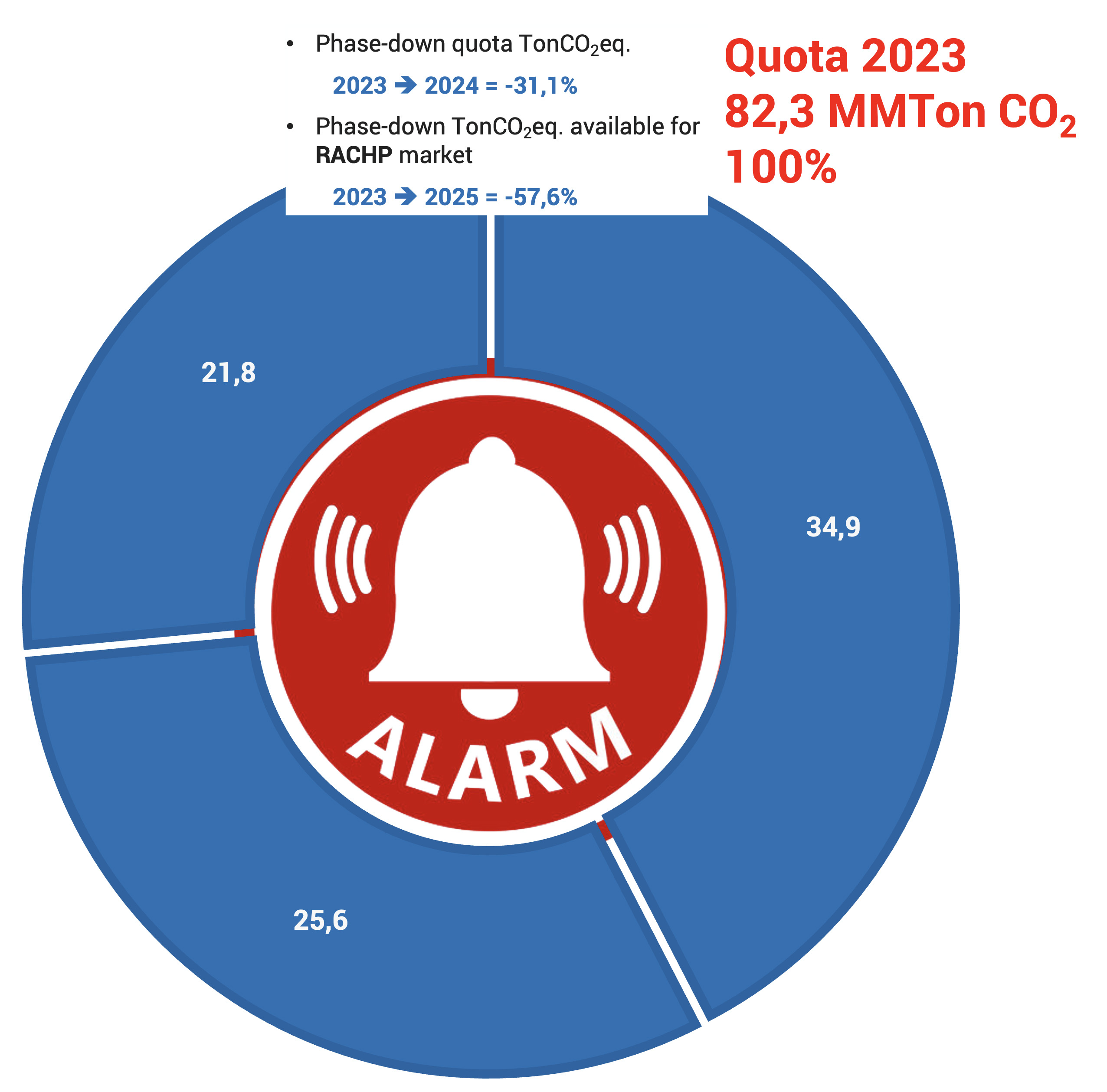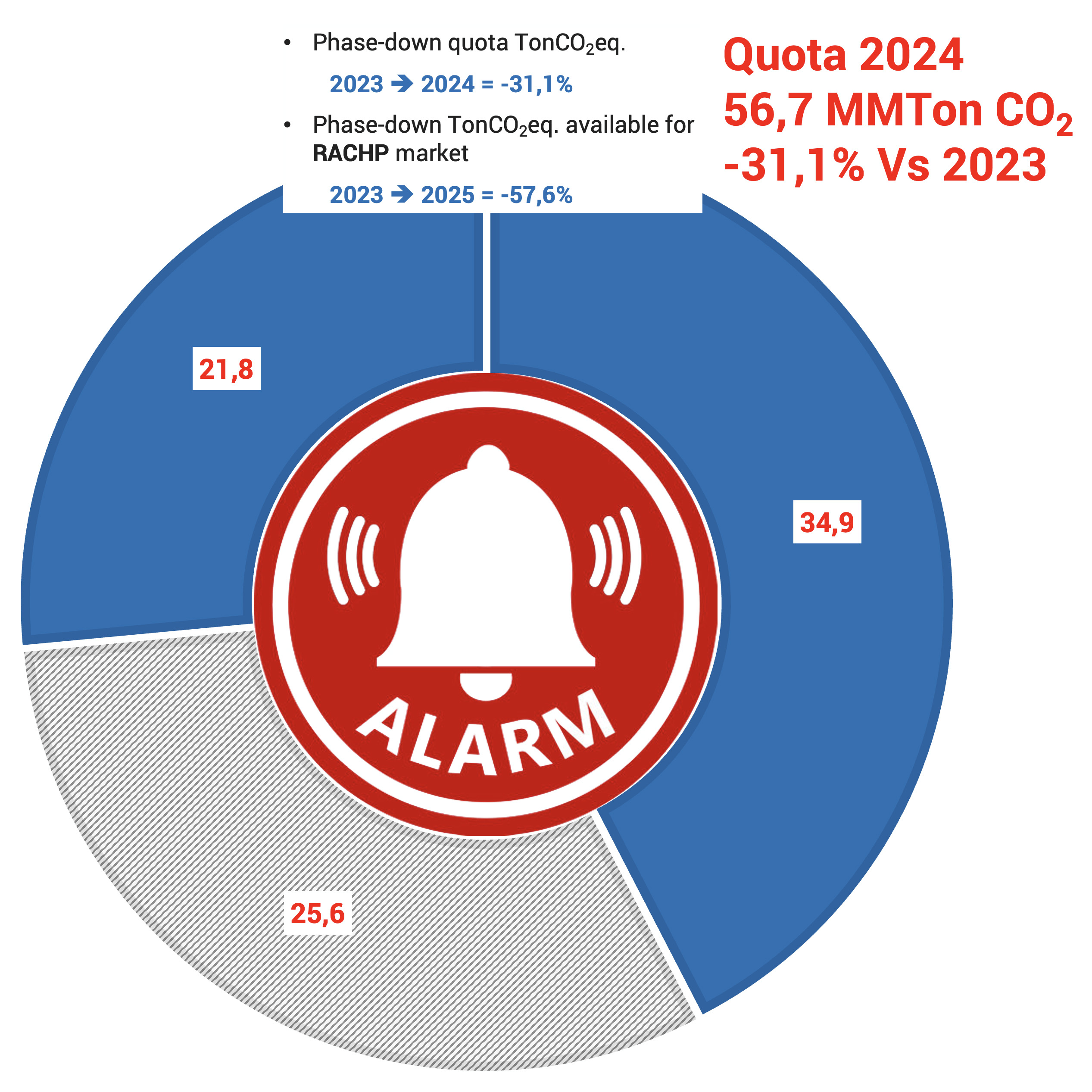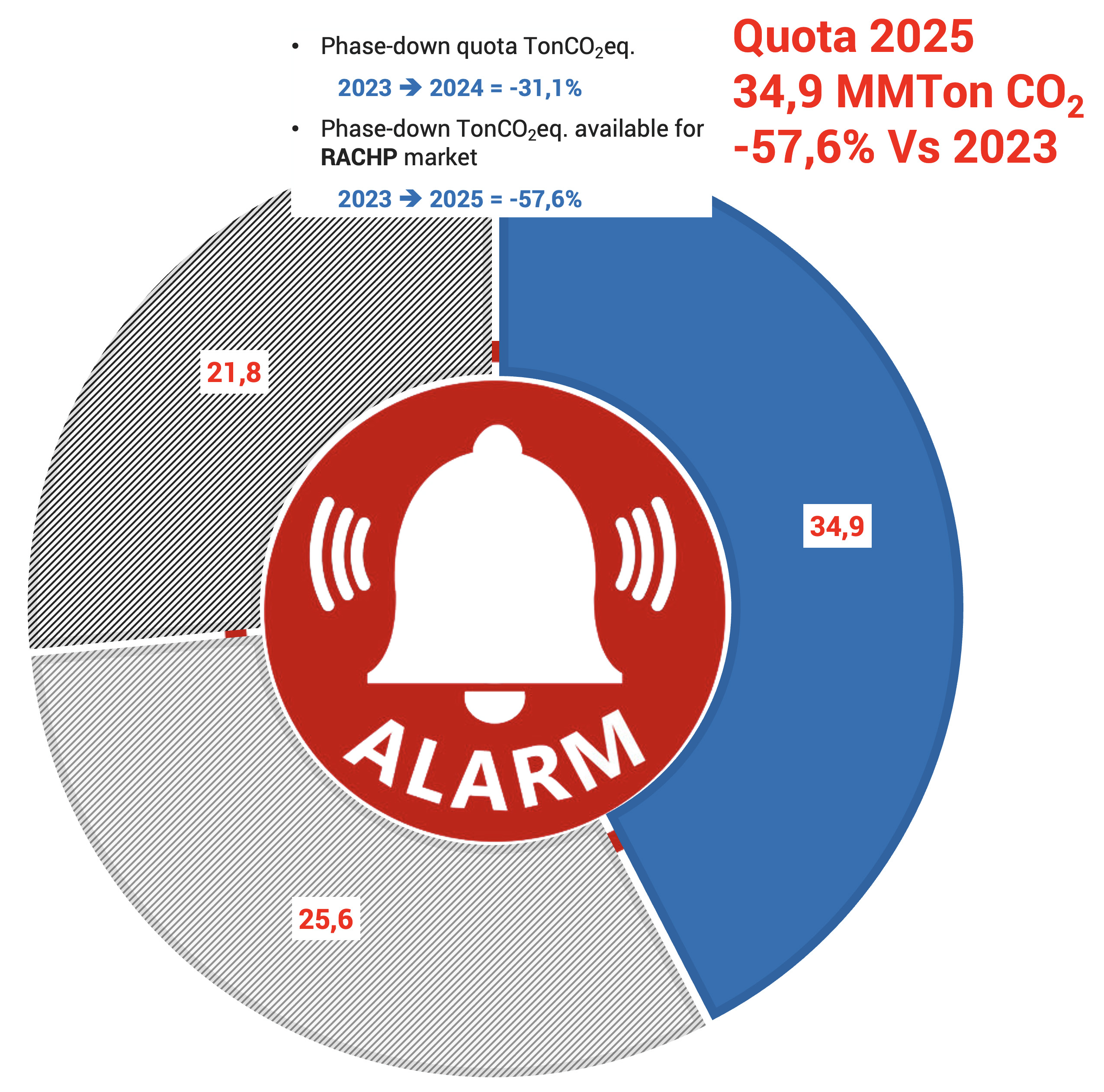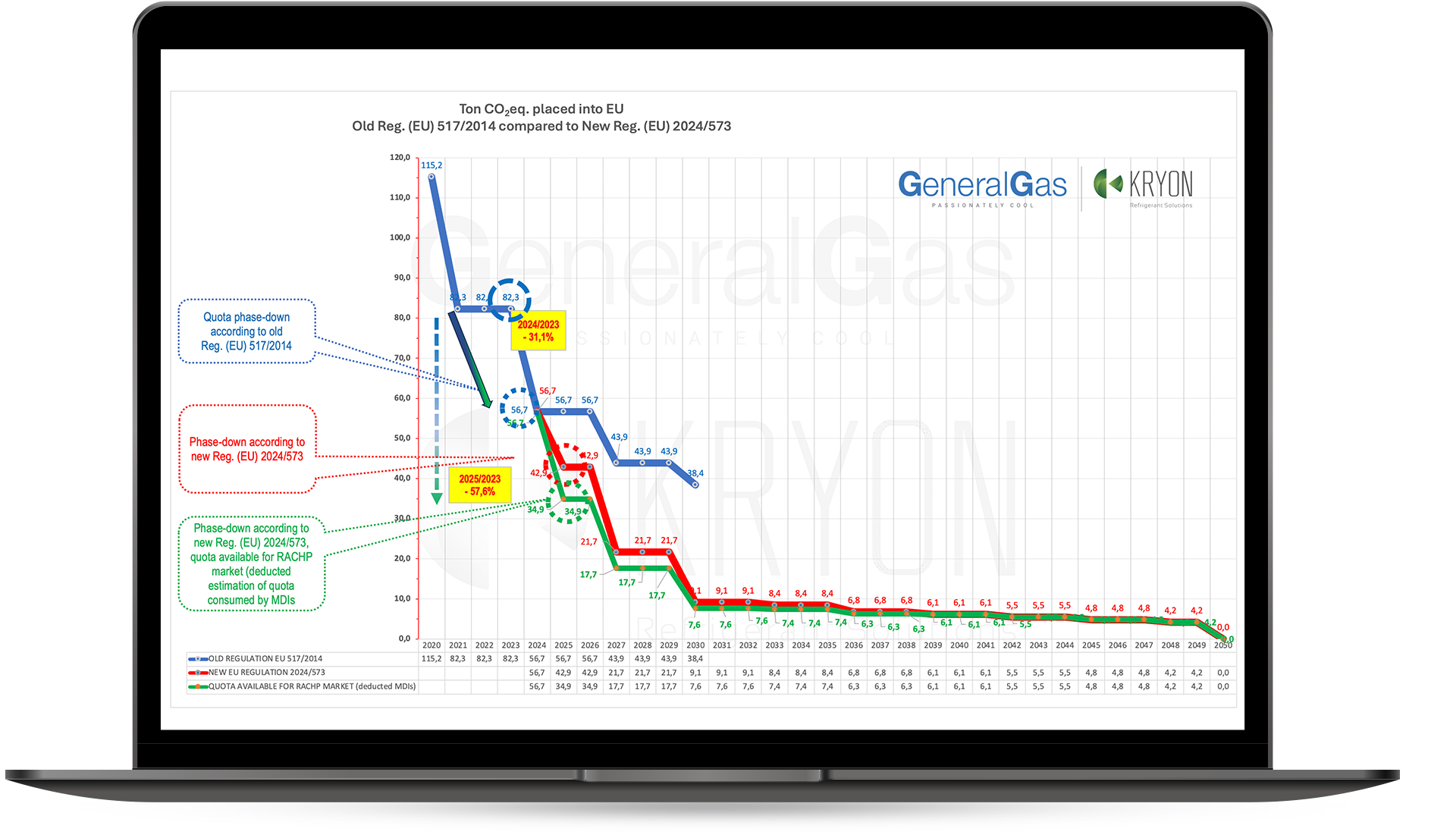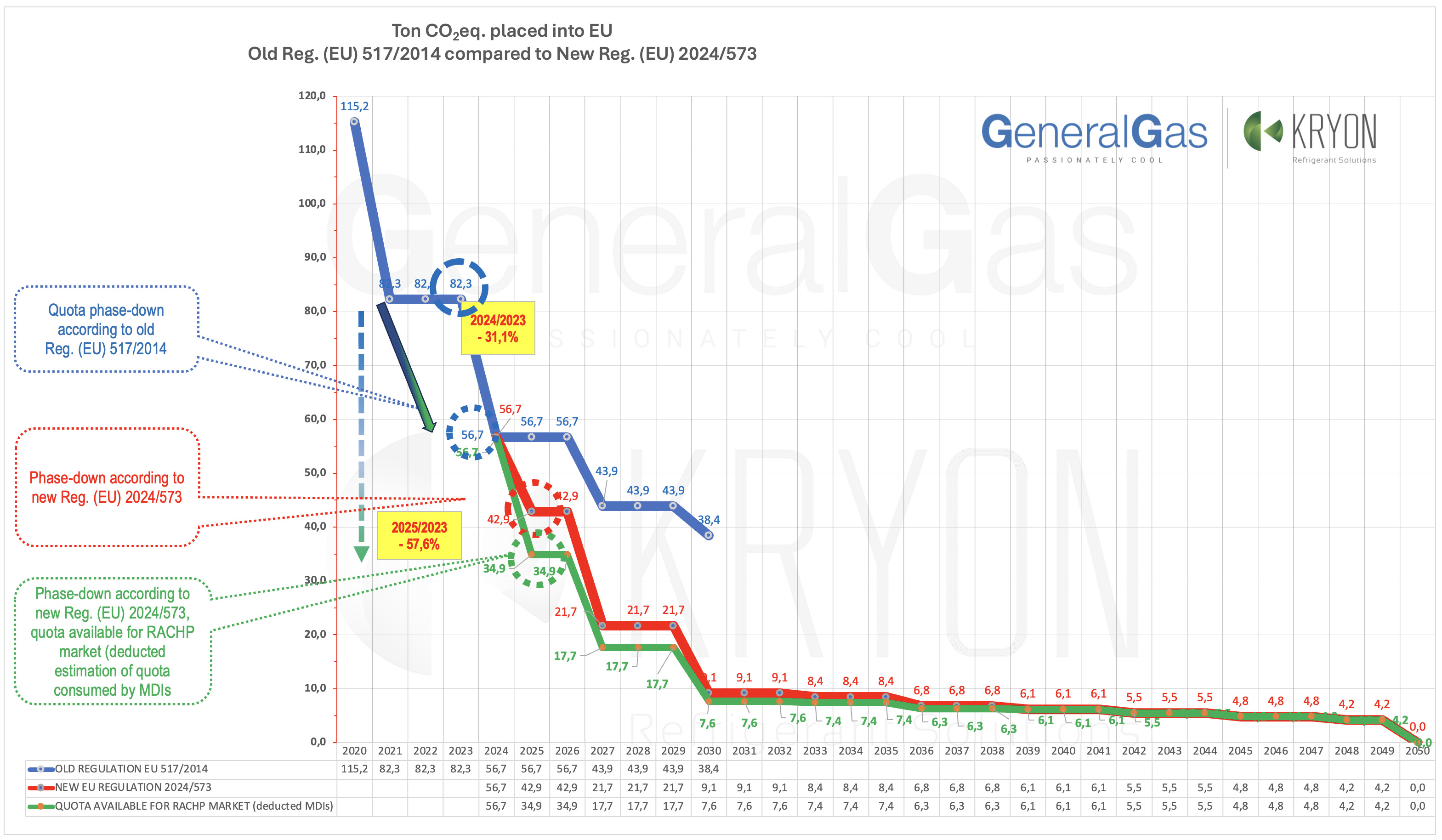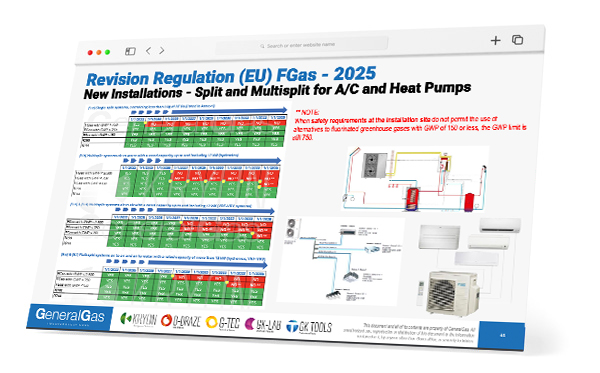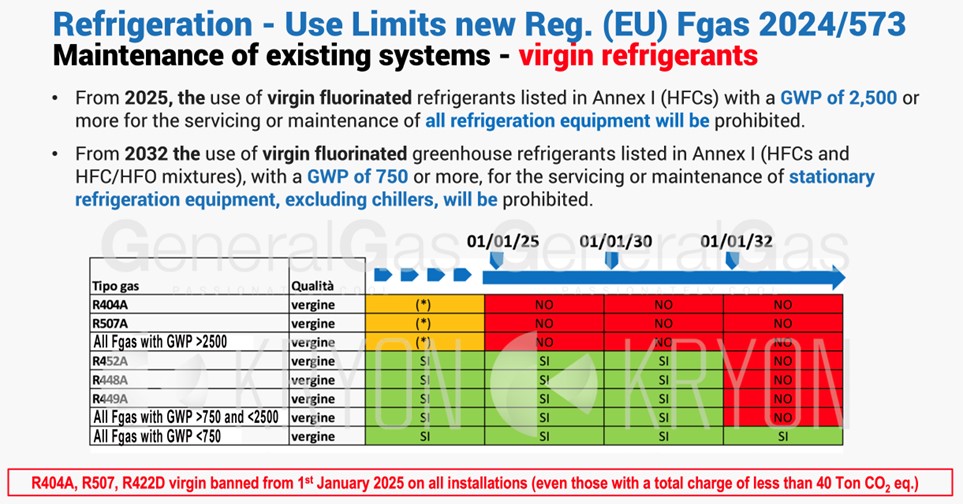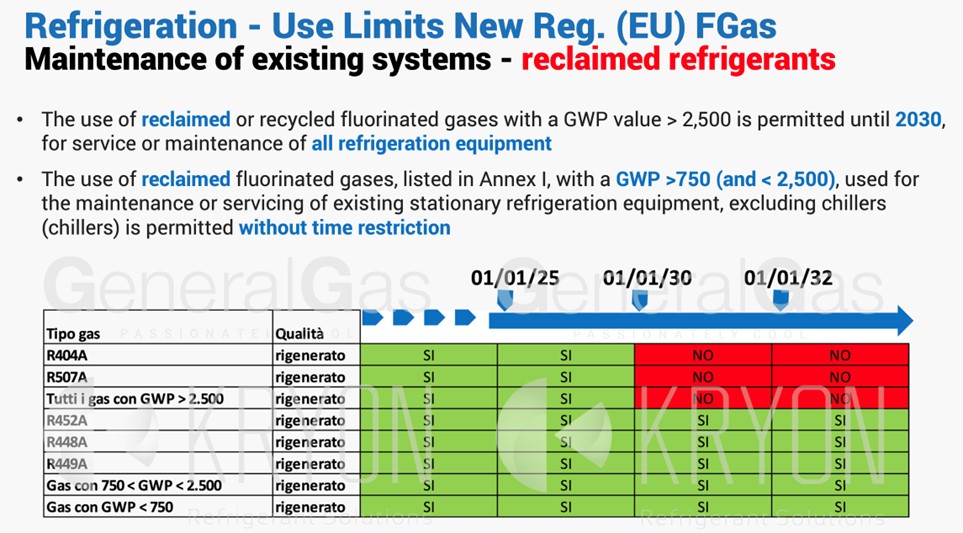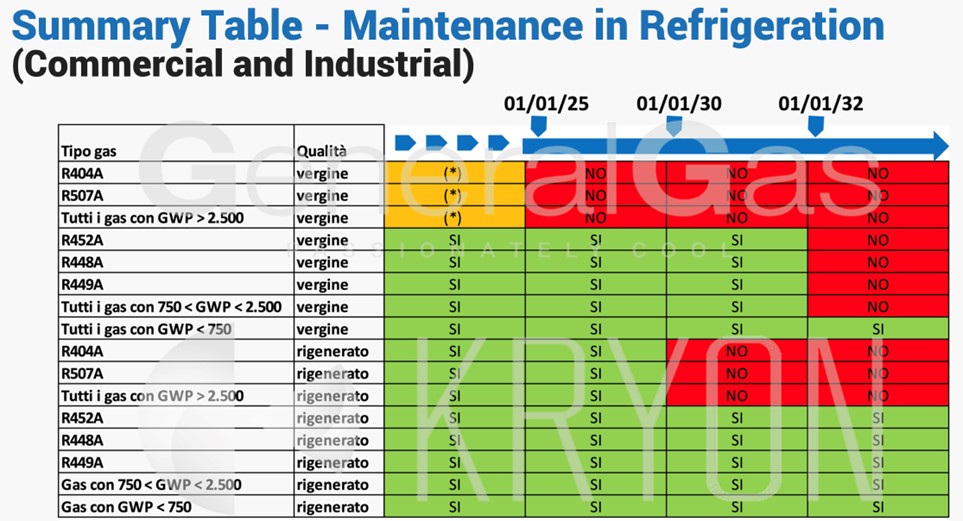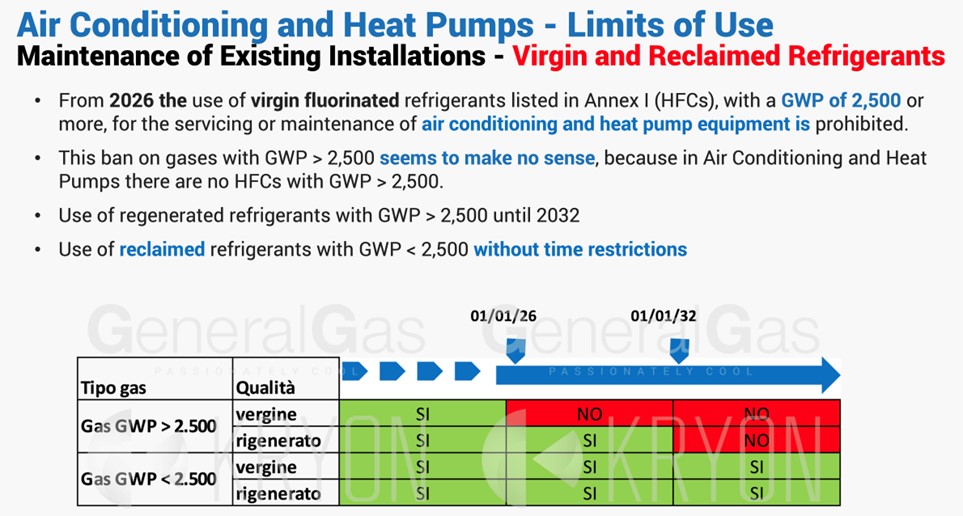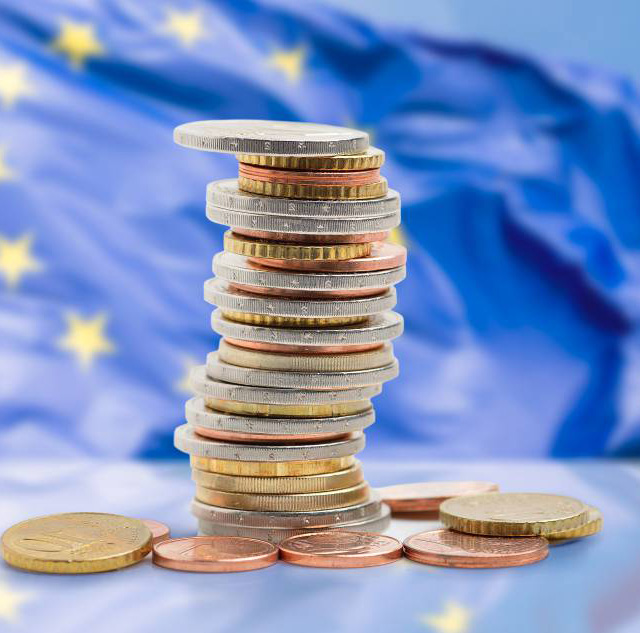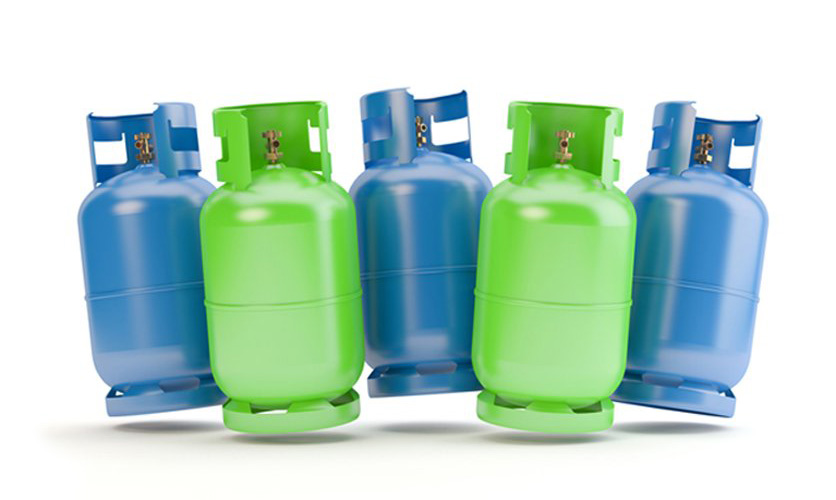NEW SYSTEMS
Stationary refrigeration
Domestic chillers and freezers - par. 2 Annex IV
Total ban on the use of F-gases from 1 January 2026 (except when required to comply with installation safety requirements)
Refrigerators and freezers for commercial use only (self-contained equipment) – par. 3 Annex IV
Ban on the use of F-gases with GWP equal to or greater than 150 from 2022
Any self-contained refrigeration equipment, excluding chillers – par. 4 Annex IV
Ban on the use of F-gases with GWP equal to or more than 150 from 2025 (except when required to comply with installation safety requirements)
NOTE: Definition of self-contained equipment
By "equipment or self-contained system" we mean a refrigeration apparatus that contains an evaporator and condenser inside the machine itself, i.e. a complete (non-split) refrigeration circuit, which therefore does not require a connection of the refrigerant gas to an external line (pipe).
NOTE: Commission Implementing Regulation (EU) 2024/2729 of 22 October 2024
By way of derogation from point 4 of Annex IV to Regulation (EU) 2024/573, the placing on the market of the following equipment containing fluorinated greenhouse gases with a GWP of 150 or more shall be authorized from 1 January 2025 to 31 December 2028, provided that the equipment is labelled in accordance with Article 12(2) of that Regulation:
a) environmental simulation devices consisting of a test chamber used to reproduce different environmental conditions, such as temperature and humidity as a function of time, for applications below – 50 °C;
b) laboratory equipment used to dry liquid samples, either by spray drying or freeze-drying;
c) laboratory centrifuges, i.e. equipment that separates fluids of different densities from solids in a rapidly rotating container.
NOTE: Commission Implementing Regulation (EU) 2024/3120 of 16 December 2024
By way of derogation from point 4 of Annex IV to Regulation (EU) 2024/573, the placing on the market of mechanical cryogenic freezers (–150°C) containing fluorinated greenhouse gases with a GWP of 150 or more shall be authorized from 1 January 2025 to 31 December 2028, provided that the equipment is labelled in accordance with Article 12(2) of that Regulation.
NOTE: Commission Implementing Regulation (EU) 2024/3122 of 16 December 2024
By way of derogation from point 4 of Annex IV to Regulation (EU) 2024/573, the placing on the market of blood containers and rapid contact blood plasma freezers containing fluorinated greenhouse gases with a GWP of 150 or more shall be authorized from 1 January 2025 to 31 December 2026, provided that the equipment is labelled in accordance with Article 12, paragraph 2 of that regulation.
NOTE: Commission Implementing Regulation (EU) 2025/33 of 13 January 2025.
By way of derogation from point 4 of Annex IV to Regulation (EU) 2024/573, the placing on the market of the following types of self-contained refrigeration equipment containing fluorinated greenhouse gases with a GWP of 150 or more is authorised from 1 January 2025 to 30 June 2026, provided they are labelled pursuant to Article 12(2) of Regulation (EU) 2024/573:
(a) blast cabinets with a full load capacity from 25 kg to 100 kg of foodstuff;
(b) artisanal gelato ice cream makers with a cooling capacity higher than 2 kW;
(c) ice makers with an ice production capacity from 200 kg to 2 000 kg per 24 hours;
(d) trolleys for preserving and regenerating food with rated power input from 1,5 kW to 10,5 kW;
(e) retarder prover cabinets with an absorbed power from 1 kW to 2 kW;
(f) frozen drinks dispensers and cold cream dispensers with a chilled full load capacity greater than 3 litres.
Single-stage refrigeration systems (excluding chillers), self-contained equipment and multipack centralized refrigeration systems – par. 5 Annex IV
Ban on the use of F-gases with a GWP of 2,500 or more from 1 January 2025, and of F-gases with a GWP of 150 or more from 1 January 2030.
Multipack centralized refrigeration systems for commercial use, with a nominal power equal to or greater than 40 kW – par. 6 annex IV
Primary Circuit:
Ban on the use of F-gases with GWP equal to or greater than 1,500 from 1 January 2022.
Secondary Circuit:
Ban on the use of F-gases with GWP equal to or greater than 150 from 1 January 2022.
NOTE: Multipack Central Refrigeration Systems: A "multipack" is a system with two or more compressors operated in parallel, connected to one or more common condensers and a range of cooling devices such as display cases, cabinets and freezers, or to refrigerated warehouses.
NEW SYSTEMS
Chillers for refrigeration, process, storage and human comfort (A/C) - par. 7 Annex IV
Chillers with rated power up to 12 kW
Prohibition of the use of F-gases with GWP equal to or more than 150 from 1 January 2027 (except when required and necessary to meet safety requirements).
NOTE: The current version of the Regulation provides for the prohibition of the use of any fluorinated gas from 1 January 2032 (a possible revision is however planned in 2030, with the possibility of allowing the use of fluorinated gases with a GWP of less than 150, without time limits).
Chiller with rated power above 12 kW
Ban on the use of F-gases with GWP equal to or more than 150 from 1 January 2027 (except when required and necessary to meet safety requirements)
NOTE: Chiller means a single system whose main function is to cool a heat transfer fluid (such as water, glycol, brine or CO2) for refrigeration, process, conservation or human comfort purposes.
NEW SYSTEMS
Self-contained air conditioning and heat pump systems (excluding chillers) - par. 8 Annex IV
Plug-in room air conditioners, which can be moved between rooms by the end user
Ban on the use of F-gases with GWP 150 or more from 2020 (unchanged)
Plug-in room air conditioning equipment, mono-block air conditioning equipment and other self-contained A/C equipment and self-contained heat pumps, with a maximum rated capacity of up to and including 12 kW
Ban on the use of F-gases with GWP equal to or more than 150 from 1 January 2027 (except when required and necessary to meet safety requirements)
Ban on the use of all F-gases from 2032 (except when required and necessary to meet safety requirements)
NOTE: a "mono-block" air conditioner is an air conditioning unit that contains all the typical components of an air conditioning system (refrigeration circuit, evaporator, compressor, condenser, fan, etc.).
NOTE: When the safety requirements at the installation site do not allow the use of alternatives to fluorinated greenhouse gases with a GWP equal to or less than 150, the GWP limit is still 750.
Mono-block and other self-contained air-conditioning equipment and heat pumps, with a maximum rated power exceeding 12 kW but not exceeding 50 kW
Ban on the use of F-gases with GWP equal to or greater than 150 from 1 January 2027 (except when required and necessary to meet safety requirements)
NOTE: When the safety requirements at the installation site do not allow the use of alternatives to fluorinated greenhouse gases with a GWP equal to or less than 150, the GWP limit is still 750.
Other self-contained air conditioning and heat pump equipment
Ban on the use of F-gases with GWP equal to or greater than 150 from 1 January 2030 (except when required and necessary to meet safety requirements)
NOTE: When safety requirements at the installation site do not allow the use of alternatives to fluorinated greenhouse gases with a GWP of 150 or less, the GWP limit is still 750.
NEW SYSTEMS
Split systems for air conditioning and heat pumps - par. 9 Annex IV
Single split systems, containing less than 3 kg of HFCs (listed in Annex I)
Ban on the use of F-gases with GWP equal to or more than 750 from 1 January 2025
Air-to-water multi-split systems with a maximum rated power of up to 12 kW (hydronic systems)
Ban on the use of F-gases with GWP equal to or more than 150 from 1 January 2027 (except when required and necessary to meet safety requirements)
Ban on the use of all F-gases from 1 January 2035 (except when required and necessary to meet safety requirements)
NOTE: When safety requirements at the installation site do not allow the use of alternatives to fluorinated greenhouse gases with a GWP of 150 or less, the GWP limit is still 750.
Air-to-air multi-split systems with a maximum rated power of up to 12 kW (VRF-VRV systems)
Ban on the use of F-gases with GWP equal to or greater than 150 from 1 January 2029 (except when required and necessary to meet safety requirements).
Ban on the use of all F-gases from 1 January 2035 (except when required and necessary to meet safety requirements).
NOTE: When safety requirements at the installation site do not allow the use of alternatives to fluorinated greenhouse gases with a GWP of 150 or less, the GWP limit is still 750.
Air-to-air and air-to-water multi-split systems with a rated power of more than 12 kW (hydronic and VRF-VRV systems)
Prohibition of the use of F-gases with GWP equal to or more than 750 from 1 January 2029 (except when required and necessary to meet safety requirements)
Prohibition of the use of F-gases with GWP equal to or morer than 150 from 1 January 2033 (except when required and necessary to meet safety requirements)
NOTE on safety requirements:
The safety requirements are established, depending on the specificities of the site and the application:
European Union Law or Member State Law;
By a non-legally binding act containing technical documentation or standards that must be applied to ensure safety at the specific location, provided that they are in line with the relevant European Union law or Member State Law.


